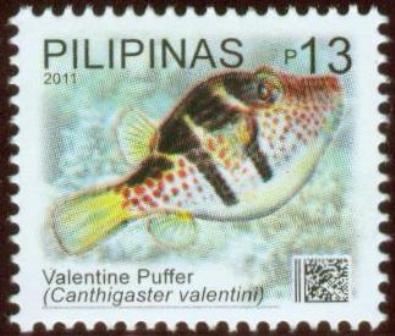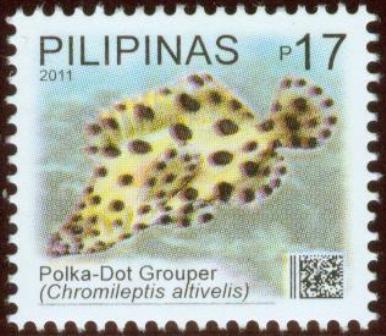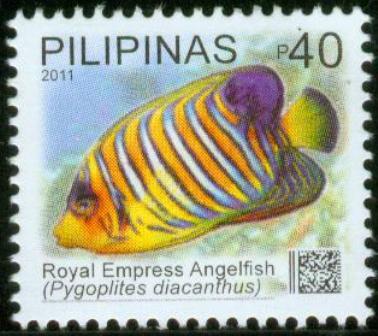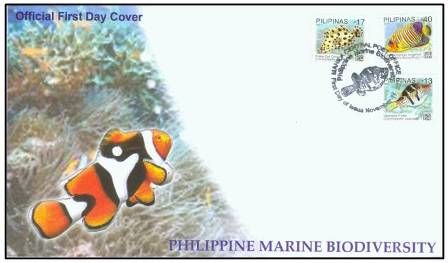2011, November 11. Marine Biodiversity (Definitives)
Litho Offset. APO Productions Unit. Perf. 14 1/4; Bar Code on Each Stamp.
Singles , Sheets of 100 (10 x 10)



13p Valentine Puffer - Singles (250,000)
17p Polka Dot Grouper - Singles (1,580,000)
40p Royal Empress Angelfish - Singles (960,000)
Source: Coral Reef Animals of the Indo-Pacific by Dr. Terence Gosliner
First Day Covers: Manila
VALENTINI PUFFER (canthigaster valentine). Also known as the Black Saddle Pufferfish, Blacksaddled Toby, Valentini Toby, or Saddled Toby is from the Indo-Pacific region where it can be found among coral heads and rocks of lagoon and seaward reefs at depths of 5 to 180 feet. It has a white body with four distinct black stripes on the upper half. The body is also covered with brownish-orange dots. It has yellow fins, and blue striping running along the back. It lacks pelvic fins, but has learned to use the pectoral fins to move. http://www.aquariumslife.com/saltwater-fish/marine-puffer/valentini-puffer-canthigaster-valentini/
POLKA DOT GROUPER (Cromileptes altivelis). This species is easily distinguished by its extreme smallness of size of the anterior part of the head as compared to the elevated postorbital part; absence of canine teeth, except for a very small pair at the front of the upper jaw; a slit-like posterior nostril; color greenish white to light greenish brown with scattered round black spots on head, body, and fins, with body spots generally larger than those on head and fins; about 9 large roundish dusky blotches may be present on body, with some extending partly into base of dorsal and anal fins. http://www.fishbase.org/summary/Cromileptes-altivelis.html
ROYAL EMPRESS ANGELFISH (Pygoplites diacanthus). Also known as Regal Angelfish, Royal Angelfish. inhabits parts of lagoons and seaward reefs where the coral growth is prolific. Its depth range is 1-48 meters / 3-157 feet and it occurs singly, in pairs and (rarely) in groups. This species appreciate environments where it can duck in and out of crevices and similar hiding spots. The hiding spots must have good circulation. The sides of the body feature alternating dark-edged bluish white and orange stripes. In the dorsal fin, these stripes become narrower and angle backward. The posterior portion of the dorsal fin is black and adorned with close-set blue spots. The posterior portion of the anal fin sports alternating yellow and blue bands that run parallel to the body contour. The caudal fin is yellow. http://www.aquaticcommunity.com/Marine-angelfish/Regal.php
-
Marine Biodiversity
